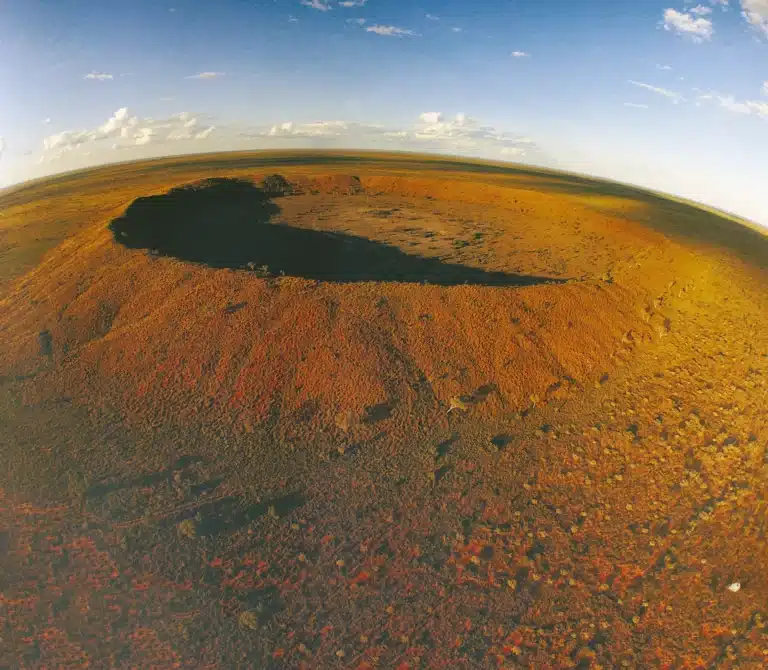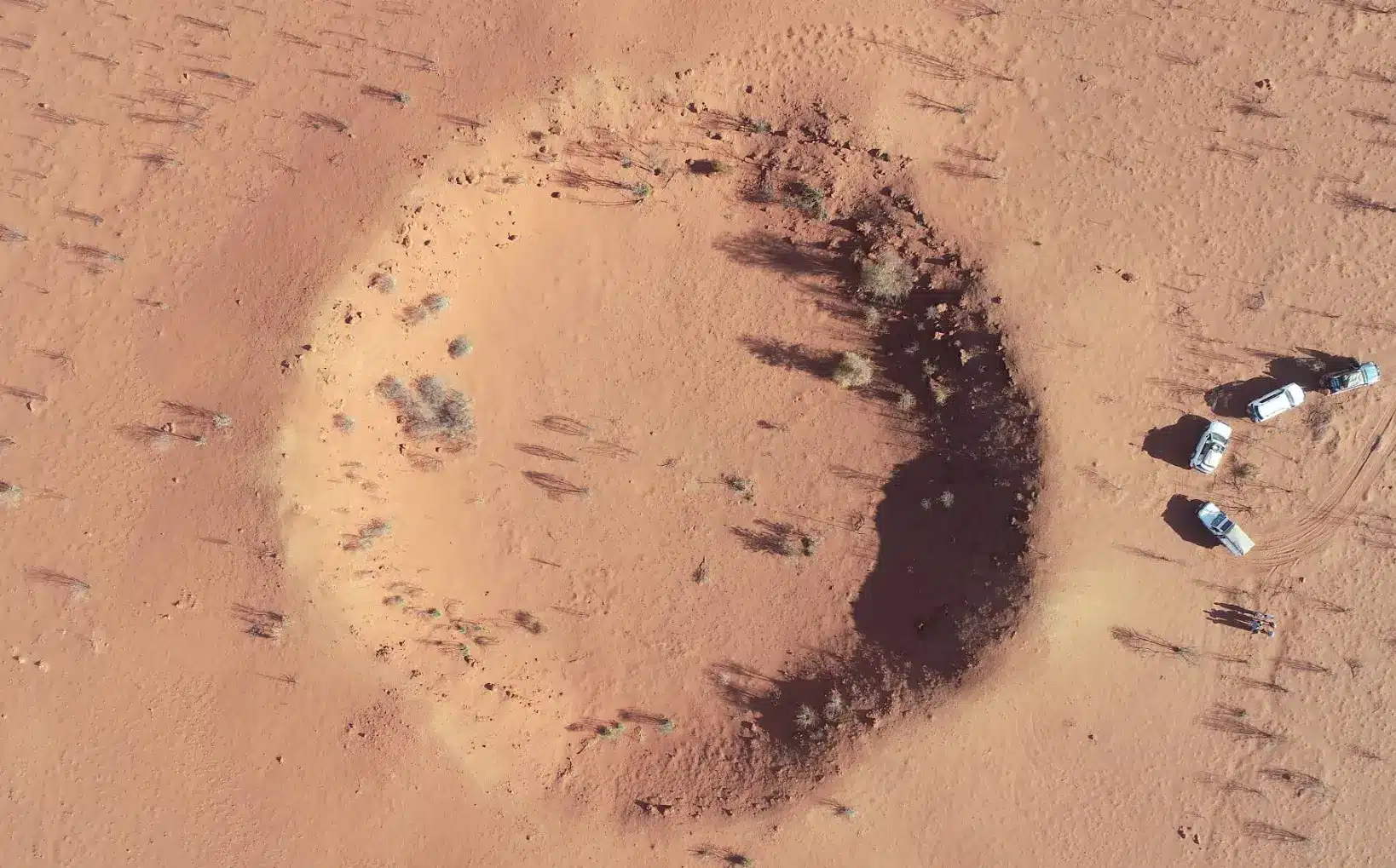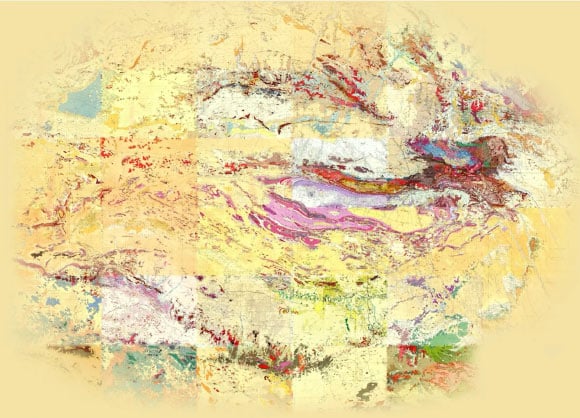Five Australian meteorite craters you can actually visit




More than just big holes in the ground, Australian meteorite craters are the visually stunning remnants of our continent’s violent past. We tell you why you should visit them and how to get there.
Throughout its 4.5 billion-year history, Earth has been struck by countless meteorites. However, thanks to erosion and tectonic activity, most impact craters have vanished from the surface. Fortunately, several remain visible across Australia, offering a rare glimpse into these cataclysmic events.
Here, we identify five meteorite craters in Australia that you can visit on your travels, though be warned – they’re all in remote locations requiring careful preparation. Each crater tells a unique story of cosmic collision, and visiting them is an unforgettable outback adventure.
This is arguably Australia’s most famous meteorite crater, made infamous by the film of the same name. Unfortunately, the frightening movie has deterred many travellers who fear encountering a deranged psychopath in the outback. It’s a pity, because those who skip this site miss out on something truly spectacular.
Located about 145 kilometres south of Halls Creek on the Tanami Road, Wolfe Creek Crater measures 880 metres in diameter and is remarkably well-defined, with an outer rim rising 60 metres above the surrounding desert floor. The crater formed when a massive meteorite smashed into Earth less than 120,000 years ago, making it relatively young in geological terms.
Both the rim and crater basin are accessible via reasonably easy walking tracks. A 200-metre return walk takes you to the crater rim, though it involves a steep rocky climb. The views from the top are worth the effort – you’ll see the full scale of this cosmic impact site.
The nearby campground offers excellent facilities for such a remote location. Camping is free, and basic toilets are available. However, you must bring all your own water, food and supplies, as none are provided. Access requires 4WD capability due to corrugations on the Tanami Road, and the final 23-kilometre access road can be challenging.
The traditional custodians, the Jaru people, know the crater as Kandimalal. In their Dreaming stories, it marks the spot where a rainbow snake emerged from the ground during creation time. Aboriginal people have known about this extraordinary site for tens of thousands of years.
For current road conditions and park alerts, check the WA Parks website before travelling.
Located about 145 kilometres southwest of Alice Springs, just five kilometres off the Stuart Highway on Ernest Giles Road, Henbury is unique among Australian meteorite craters. Instead of a single impact site, you’ll find 12 to 13 distinct craters clustered in close proximity to each other.
This remarkable landscape formed around 4,700 years ago when a large meteorite fractured into multiple pieces during its fiery descent through Earth’s atmosphere. The fragments hit the ground at more than 40,000 kilometres per hour, creating an almost alien landscape unlike anywhere else in Australia. Because this impact occurred so recently in cosmological terms, Aboriginal people in the area likely witnessed the terrifying event.
The craters vary dramatically in size, ranging from six metres to 180 metres in diameter, with depths reaching up to 15 metres. The circular shape of the larger craters remains clearly visible from the rims, while the smallest craters require careful observation to spot. Walking the self-guided track around the crater field is best done in early morning or late afternoon when the low sun defines each crater’s shape.
The conservation reserve includes a small campground with basic facilities adjacent to the carpark. Here’s what’s changed: NT Parks now requires all non-NT residents to purchase a Parks Pass before visiting. Additionally, camping fees apply to all visitors, and you must book your campsite online before arrival. The reserve doesn’t supply water or firewood, so bring everything you need.
Ernest Giles Road is generally a good dirt road accessible to conventional vehicles, though corrugations can develop. If you’re towing a caravan, take it slowly to avoid damage.
Contact the Alice Springs Telegraph Station on (08) 8952 1013 for current conditions, or visit the NT Parks website for more information.
When a comet 600 metres wide slammed into Earth approximately 142.5 million years ago, it created one of the most spectacular impact sites on the planet. Today, the visible remnant of this cataclysmic event is five kilometres in diameter, with crater walls rising 180 metres above the surrounding landscape.
Located 175 kilometres west of Alice Springs, Tnorala (the Western Arrernte Aboriginal name for the site) looms on the horizon like an out-of-place mountain range. Remarkably, the traditional Aboriginal interpretation of this formation is also celestial in origin. According to Western Arrernte Dreaming, Tnorala was formed when a baby’s wooden carrier fell from the dancing women of the Milky Way and crashed to Earth.
Access to the crater is via either Larapinta Drive or Namatjira Drive. The final 10 kilometres require a 4WD vehicle, as the track can be sandy and rough. Once inside the reserve, you can take short walking tracks to lookouts that provide panoramic views of the crater’s interior. However, walking directly on the crater rim is not permitted due to its cultural significance.
The reserve offers basic facilities including toilets, picnic areas and information shelters. Camping and fires are not permitted within Tnorala Conservation Reserve. Like other NT parks, a Parks Pass is required for all non-NT residents.
The reserve is open year-round, though roads may close after heavy rain. The cooler months from April to September provide the most comfortable visiting conditions. Before travelling, check current conditions on the NT Parks website.
Getting to Boxhole Crater presents a genuine challenge, not because it’s physically difficult to access, but because it’s something of an outback secret. It’s not widely promoted, and signage is minimal at best.
To find this hidden gem, travel north from Alice Springs along the Stuart Highway and turn right onto the Plenty Highway. After 166 kilometres, turn left onto the Binns 4WD Track and continue for another 39 kilometres. At that point, you should be in the general vicinity of the crater, located on Dneiper Station pastoral property.
At 170 metres in diameter, Boxhole is one of the smaller craters on this list. Nevertheless, it’s extraordinarily well-preserved for its age of approximately 5,400 years. The rim rises 10 to 17 metres above the crater floor, and the circular shape remains clearly defined despite millennia of desert winds and rare rain events.
The crater itself is fenced off, with a short walk required from where you park on the track. There are no camping facilities at the crater site itself. The nearest services are back at settlements along the Stuart Highway, so plan accordingly with fuel, water and supplies.
This is strictly 4WD territory, and you should be entirely self-sufficient for remote area travel. The isolation is part of Boxhole’s charm – you’ll likely have the entire crater to yourself.

This destination is reserved for truly adventurous travellers, as it ranks among Australia’s most remote and challenging sites to reach. Veevers Crater sits in the vast Western Australian desert between the Great Sandy Desert and the Gibson Desert. The closest populated centre is Kintore, a staggering 410 kilometres away.
Access to Veevers requires travelling along the Gary Highway, an unsealed track running 323 kilometres through some of Australia’s most isolated country. The crater itself lies 16 kilometres east of the Gary Highway, accessed via a side track. This is strictly 4WD territory, and you’ll need to be completely self-sufficient with fuel, water, food, and emergency supplies.
Before you commit to this expedition, understand that Veevers is the smallest crater featured here, measuring just 70 to 75 metres in diameter. The rim rises merely 1.5 metres above the surrounding desert plain, with a central basin sinking seven metres below the rim crest.
However, Veevers crater is regarded as one of the best-preserved small meteorite craters on Earth. Its almost perfect bowl-shaped topology and pristine condition make it a site of international scientific significance. The crater is estimated to be less than 20,000 years old, possibly as young as 4,000 years.
A visitors’ book at the site contains entries from the original team who identified the crater in 1975, as well as the researchers who confirmed its meteorite origin in 1987. Finding your name among these scientific pioneers adds to the sense of achievement.
Travel along the Gary Highway requires an HF radio or satellite phone, extensive vehicle preparation, and ideally travelling as part of a convoy. This isn’t a trip for inexperienced outback travellers.

Even if you never visit any of the craters above, there’s one you may have already driven through without realising it. Located at the approximate midpoint between Uluru and Mount Conner is the centre of what scientists believe could be the largest impact crater on Earth.
This structure, called the Massive Australian Precambrian-Cambrian Impact Structure (MAPCIS), is estimated to be approximately 600 kilometres in diameter. Recent research published in 2024 has found new evidence of impact signatures, including shocked minerals and high levels of iridium. The hypothetical outermost stress field ring could extend up to 2,000 kilometres in diameter.
The impact is thought to have occurred around 545 million years ago, at the end of the Ediacaran period. If confirmed, this ancient impact event could provide crucial insights into Earth’s geological and biological evolution, potentially explaining aspects of the Cambrian Explosion when complex life forms rapidly diversified.
While MAPCIS remains a proposed impact structure awaiting official confirmation, the growing body of evidence is compelling. The research is led by Daniel Connelly, working with international collaborators including scientists from Virginia Commonwealth University.
Next time you’re travelling through Central Australia between Uluru and Mount Conner, consider that you might be crossing the remnant of a cosmic event of almost unimaginable proportions – an impact large enough to crack a continent.
If you’re planning to visit any of these Australian meteorite craters, thorough preparation is essential for your safety. Here’s what you need to know:

These impact sites offer more than just impressive geology. They’re windows into cosmic events that shaped our planet, places where Earth’s violent past remains visible on the landscape. Each crater tells a different story – from the recent impact at Wolfe Creek to the ancient collision that formed Tnorala.
For RV owners and outback adventurers, visiting these Australian meteorite craters combines geological wonder with the challenge and satisfaction of remote area travel. You’ll experience some of Australia’s most isolated and beautiful desert country while standing in locations that connect Earth to the wider cosmos.
Whether you’re after an accessible day trip to Henbury or planning the ultimate expedition to Veevers, these five craters offer unforgettable outback experiences for travellers prepared to venture off the beaten track.